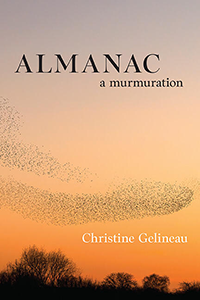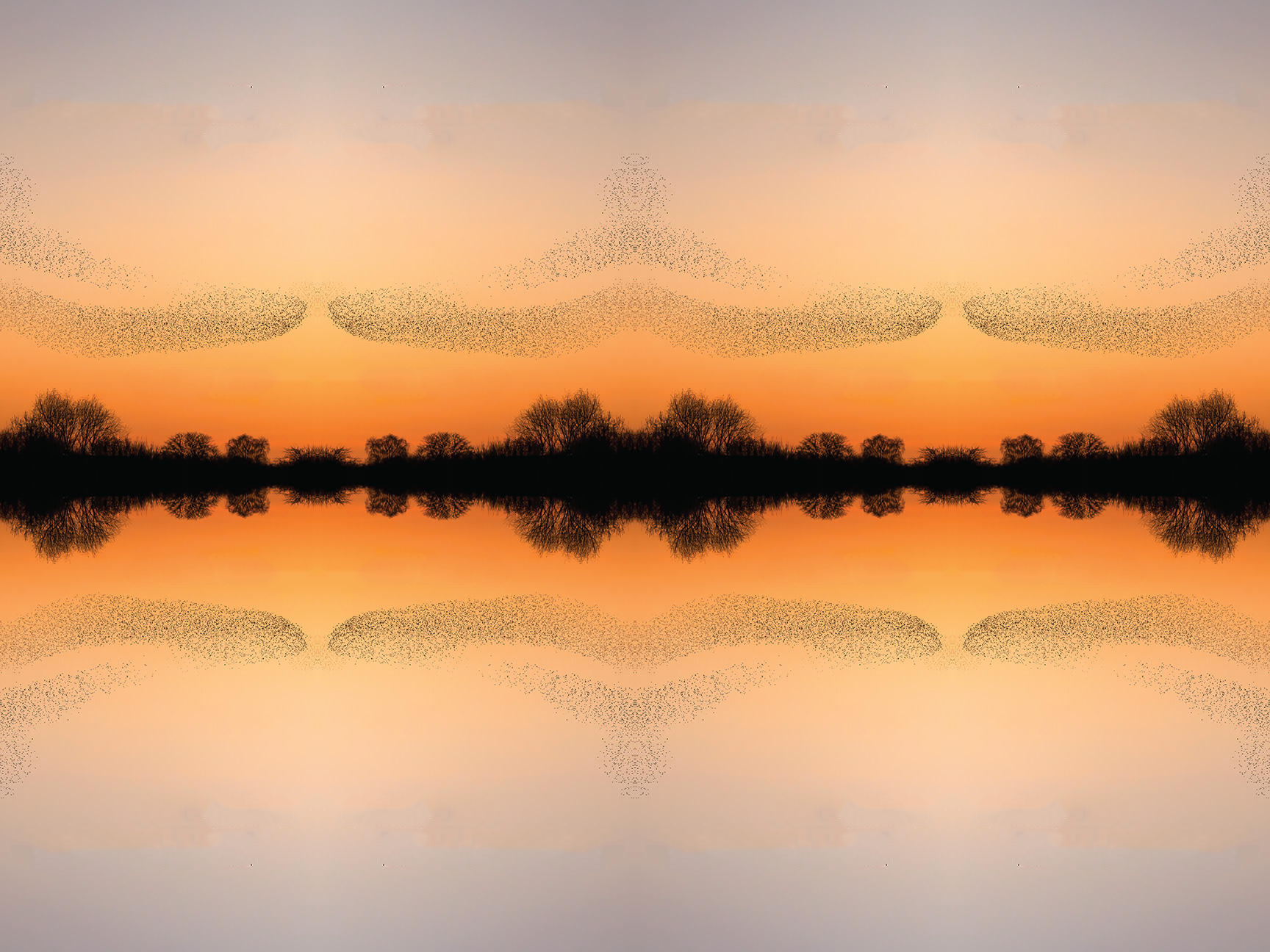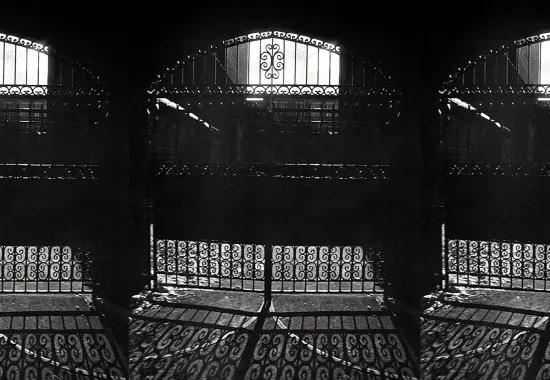A Review of Almanac: A Murmuration by Christine Gelineau
Christine Gelineau’s powerful book of prose, Almanac: A Murmuration, is part memoir, part almanac of outer and inner weather, part early American history lesson, part environmental jeremiad, and part rage against the dying of the light. As her title suggests, there’s the sound of dark complaint, a murmuration flying ominously through these pages, but there’s also the sound of hosannas for the natural world, delight for the horses within it, praise for the farm along the Susquehanna where she situates her life, and thanks for surviving several life-threatening accidents and medical conditions to somehow still carry on in her seventh decade.
How does she weave together so many disparate themes? As she says, more by synchronicity than chronology. Divided into 12 chapters—one for each month of the almanac year—she moves by seasonal moods and subtle associations through her interwoven themes. In making this synchronicity seem effortless and inevitable, therein lies some of the book’s magic. For instance, in January’s almanac entry—the first month of the year—she traces various origin stories: the origins of her mother’s family in Ireland; the origin of her parents’ romantic get-together; the births of Gelineau and her siblings; the origin of her love of horses; the early landscapes that imprinted themselves on her mind; the origin of her love of reading and writing; the origin stories we tell ourselves about early American history; and the first hints of environmental catastrophe. In other chapters, rather than evoke similarities between the month’s weather and the thematic material at hand, she employs chiaroscuro, as in the month of May, contrasting the lightness of spring’s budding flowers with the dark story of her mother’s untimely death, pneumonia spiking a temperature so high it sent her into coma. As Gelineau says in the month of June, “I wanted prose to handle time more as lyric [poetry] does than as narrative tends to, favoring synchronicity over chronology.” Whatever the technique of these almanac entries, Gelineau’s writing grows poetic whenever she records the natural world—the weather and the flora and fauna responding to it—and settles back into more straightforward prose when rehearsing personal history, American history, environmental ruination, and another dozen topics.

If we examine the various thematic strands, we discover certain commonalities, such as her critique of the racist, xenophobic underpinnings of America: in her memoir, she records the struggles of her immigrant forebears—Irish and French-Canadian—against white Anglo-Protestant colonists who treated them like “the Chinese of the Eastern States”; in her historical exploration of the Susquehanna valley where she now lives, she unearths the documents and literature that record the extirpation of the Haudenosaunee tribes who were there before her; at her family vacation spot on Cape Cod, she explores the “false narratives” of Jonathan Winthrop, John Smith, and other early white settlers who claimed God-given rights to the New World, resulting in the decimation of the Wampanoag culture that lived there. As Gelineau puts it, “The surviving literature of the period of colonization regularly reveals an admixture of elegy and opportunity."
From the full range of her topics, one of the most passionate might be Gelineau’s love of the natural world: the lyrical evocation of each month’s weather and its effect on her horse farm in the Susquehanna valley, as well as horses within it. In May, she writes, “the cunning violets, who laid low in last week’s frost, unfurl now with the perfect purple rectitude of violets.” In December, “The farm's eye is shut tight with ice, its lid powdered with stars, dreaming as the new year approaches.” And here’s a July passage of her admiration for horses: “In the wrap of summer dark, in the night pastures, you sense more than see the peaceful bulk of horse bodies near you, the amble and stroke of their hooves, the crop and snuffle of their grazing, the darkness animate, expansive, sheltered by the distant intimacy of the Milky Way’s pergola of stars, the night insects chirruping, the soft whispering of muzzles in the cool grasses, the harbor of that darkness embryonic, cherishing.” On the other end of these paeans for nature, she delivers warnings about the coming environmental catastrophes: alligators freezing in southern swamps; bear starvation in the warming Arctic; Siberian permafrost melting and giving off stinking decay and released carbon; mosquito-borne West Nile and tick-borne diseases proliferating across the country; and, finally, the world-altering virus that is COVID.
Whether as poet or memoirist, she recognizes her desire for a hybrid writing (and riding?) style that at times proceeds straightforwardly and at times leaps.
Her memoir also explores family tensions, recalling at least one occasion when police responded to domestic violence at their home. Wary of sensationalism, Gelineau treads lightly, depicting her father as both warmly attentive and explosive—how he would “pull the car to the side of the road so Christine could see the horses grazing in the pasture” but also how he would angrily argue with her mother. Similarly, Gelineau offers a balanced appraisal of her mother’s complex identity: “She was a woman in mastery of mothering, housewifery, a woman who could turn out a clean house, four spit-shined children lined up in descending order, and still have her own make-up perfectly applied, her outfit artfully coordinated and accessorized,” but she was also a “high-functioning alcoholic” in denial about her alcoholism. Clearly uncomfortable with unearthing family secrets, and aware of the impossibility of knowing the entire story, Gelineau reveals it only now that her parents are gone. As for many writers of memoir, this suppressed material provides some of the backbone and purpose for the book—to clarify difficulties, mysteries, blind spots of the past—and in the process, also clarifies that piece of American history through which they lived. Through a feminist lens, Gelineau considers her mother’s alcoholism as linked to the dearth of positive economic opportunities and societal roles available to a woman in 1950s America. From here, she begins to magnify the various oppressions of women: her own academic precarity as an adjunct professor in the late twentieth-century university; the early American, Christian patriarchal worldview that imagines “‘good’ natives like Pocahontas [who] instinctively recognize European superiority, as a good woman ‘naturally’ recognizes the superiority of her man (as God intended: see Bible)” and this same worldview that plunders the riches of the (female) Earth.
A poet as well as a memoirist, Gelineau’s memoir takes us deep into the world of contemporary verse: her befriending of such influential poets as Molly Peacock, Ruth Stone, and Maxine Kumin (the life-affirming, horse-affirming poet from New Hampshire who, over time, became mentor and friend) at crucial moments in her life. Gelineau beautifully analogizes the art of horseback riding and “riding a poem": “horseback riding as a pre-verbal, inter-species 'language' that is spoken with the whole of the body, a kinetic poetry which the 'poet' and the 'poem' create together. Riding can provide very much the same kind of mysterious interlocking with an ‘other’ that the poet feels with the material of poetry when inspiration is flowing. You’re in cooperation with, not in control of, the writing. And just so with the horse. In writing, the symbiosis is cerebral, in riding, it is bodily.” Whether as poet or memoirist, she recognizes her desire for a hybrid writing (and riding?) style that at times proceeds straightforwardly and at times leaps. She also recognizes the almost impossible task she has undertaken as a writer, trying to both “give rein to” and “to rein in” the urgencies of language: “Truth telling is the most impossible of language’s uses to achieve ... and yet, the attempt to do so anyway, is language's principal nobility.”
As Gelineau turns from personal history to American history, she cautions herself (and her readers) about language, metaphoric tropes, and false narratives that shape our inaccurate conceptions of history and cause real-world harm: how Crevecoeur’s Letters from an American Farmer “imagined an ‘unpopulated America’ where formerly poor European citizens could now be landed citizens with all the rights and privileges of the ruling class”; or how American colonists created the legal justifications leading to the “scorched earth” campaign (ordered by General Washington) that razed Oquaga village (near Gelineau’s home) and caused mass starvation of the indigenous Haudenosaunee population; or how revisionist attempts by John Smith to cast the English land-grab as a peaceful, god-ordained land-transfer led to the decimation of the Powhatan tribe (and, indeed, could have led to the decimation of all the indigenous groups).
With these reservations about language and intention in mind, she offers a similarly complex and cautious analysis of her own writing project: “A memoir written late in life has ever been a self-authored elegy, but for centuries to situate that elegy amongst observations of the natural world was to locate one’s own mortality within a context of continuity and continuance.” However, in this moment of climate catastrophe and political turmoil, she wonders if anything will endure. And she answers rather bleakly: “The only audience is the present. Our only hope is ourselves.” This bleak assessment notwithstanding, she resolves to persevere, despite various physical illnesses and accidents in her life. In the August chapter of Almanac, as summer winds down, she records a dramatic narrative of her spontaneous brain bleed, describing it in terms both vivid and immediate, but also, at times, strangely detached, as the self watches the self in crisis, using the very brain one has, to watch one’s brain on a hospital monitor as doctors search for the source of the bleeding. Happily, Gelineau’s prognosis is a return to full health. But other ailments and catastrophes aren’t far off. She contracts Long COVID, complete with brain fog, impairments to her digestive, nervous, and immune systems, a difficult period, in which she’s hollowed out and wondering whether this might be her new permanently diminished life. As if things weren’t already bad enough, one more accident befalls her: Gelineau is thrown by her normally dependable horse. In the December section of Almanac, this month heading into winter, she struggles to survive: doctors perform emergency surgery to stop bleeding in the brain, and Christine Gelineau wakes up in ICU, still knowing “who I was, where I was, why I was there. I woke up cognitively intact …. I woke up from brain surgery. And I woke up as me.” Gelineau’s writing crackles with energy as she describes the minutiae of her surgery and condition: “A surgeon actually peeled back a horseshoe of skin from my scalp, drilled through my skull, and vacuumed a blood clot out of my brain. [There were also] all the broken bones—both hands, four ribs, and the right scapula.” Despite all of this, she concludes the memoir on a rather upbeat note: “Like a three-legged dog which accepts what is left of his life with joie de vivre,” she must do the same. And even more optimistically, she imagines getting back on her horse again, likening herself to the mythical centaur, who feels the horse part of the human body, extending its power and gracefulness, and she considers that young horse beneath her own aging body giving her the illusion of sustained youth, which matches her faith in an ongoing, vigorous mental capacity. The book itself, Almanac: A Murmuration, signifies the strength of her recovery. Gelineau ends the book with gorgeous images of the natural world in a quiescent winter state: “In the warm pod of the automobile, floating home from a celebration, the black woodlots and inky swept-out hayfields interspersed with the cheerful smear and spray of Christmas lights on the houses we pass. Those holiday lights are the vestiges of ancient solstice fires, the bright beseeching fires our distant ancestors built to lure back the waning sun. The after-solstice winter dawn a dawning of yet one more chance a blossoming springtime will be on our horizon.”
Recommended
Clark O Lucky Day
A Review of Jim Reese's Coming to a Neighborhood Near You






